#353 Tomorrow's picture: June 06, 1996
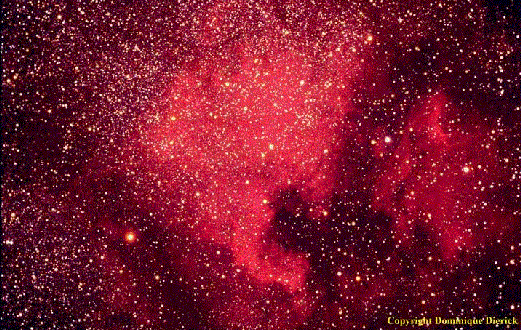
“Here's a familiar shape in an unfamiliar location! This emission nebula is famous partly because it resembles Earth's North American Continent. To the right of the North America Nebula is a less luminous Pelican Nebula. Let's be grateful that pelicans aren't really that large! The two emission nebula are located about 1500 light years away and are separated by a dark absorption cloud. The nebulae can be seen without a telescope from a dark location. Look for a small nebular patch north-east of Deneb in the constellation of Cygnus. It is still unknown which star or stars ionize the red-glowing hydrogen gas."
Copyright: Dominique
Dierick and Dirk De la Marche
#354 Tomorrow's picture: June 07, 1996
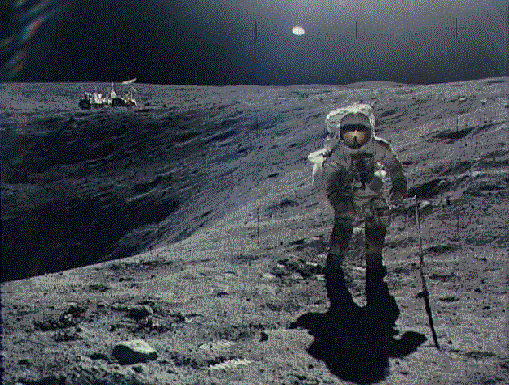
“Apollo 16 spent three days on Earth's Moon in April 1972. The fifth lunar landing mission out of six, Apollo 16 was famous for deploying and using an ultraviolet telescope as the first lunar observatory, and for collecting rocks and data on the mysterious lunar highlands. In the above picture, astronaut John W. Young photographs Charles M. Duke, Jr. collecting rock samples at the Descartes landing site. Duke stands by Plum Crater while the Lunar Roving Vehicle waits parked in the background. The Lunar Roving Vehicle allowed the astronauts to travel great distances to investigate surface features and collect rocks. High above, Thomas K. Mattingly orbits in the Command Module."
Copyright: Public domain
#355 Tomorrow's picture: June 08, 1996
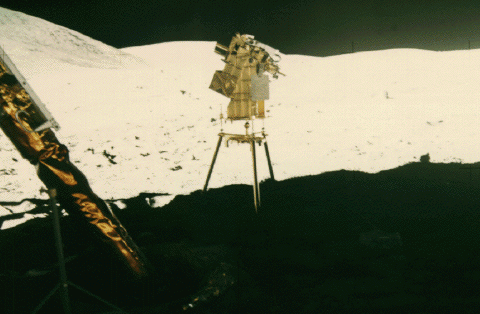
“The first and only lunar astronomical observatory was deployed by the Apollo 16 crew in 1972. The Far Ultraviolet Camera / Spectrograph used a 3-inch diameter telescope to photograph the Earth, various nebulae, star clusters, and the Large Magellanic Cloud. The camera is seen above placed in the shadow of the Lunar Module so it would not overheat. A leg of the Lunar Module enters the picture from the left. The camera took pictures in ultraviolet light which would normally be blocked by the Earth's atmosphere. The Far Ultraviolet Camera was created by George Carruthers (NRL), had a field of view of 20 degrees, and could detect stars having visual magnitude brighter than 11. 178 images were recorded in a film cartridge which was returned to Earth. The observatory stands on the Moon even today."
Copyright: Public domain
#356 Tomorrow's picture: June 09, 1996
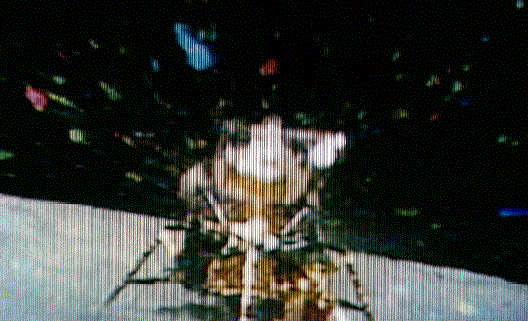
“How did the astronauts get back from the Moon? The Lunar Module that landed two astronauts on the Moon actually came apart. The top part containing the astronauts carried additional rocket fuel which allowed it to blast away, leaving the bottom part on the Moon forever. The top part would later meet up with the Command Module and its astronaut pilot, which were continually orbiting the Moon. All would then return to Earth together. The above picture was taken by a robot TV camera left on the Moon by the crew of Apollo 16. The frame above captures the top part of the Lunar Module just at it was blasting off."
Copyright: Public domain
#357 Tomorrow's picture: June 10, 1996
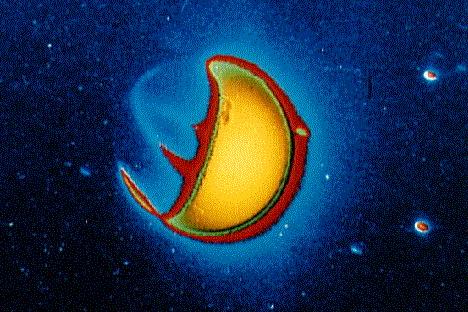
“Here's a switch: the above picture is of the Earth taken from a lunar observatory! This false color picture shows how the Earth glows in ultraviolet (UV) light. UV light is so blue humans can't see it. Very little UV light is transmitted through the Earth's atmosphere but what sunlight does make it through can cause a sunburn. The Far UV Camera / Spectrograph deployed and left on the Moon by the crew of Apollo 16 took the above picture. The part of the Earth facing the Sun reflects much UV light, but perhaps more interesting is the side facing away from the Sun. Here bands of UV emission are also apparent. These bands are the result of aurora and are caused by charged particles expelled by the Sun spiraling to Earth along magnetic field lines."
Copyright: Public domain
#358 Tomorrow's picture: June 11, 1996
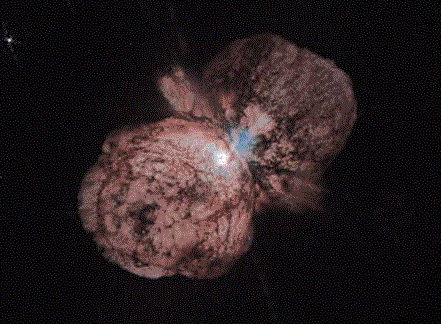
“Carinae may be about to explode. But no one knows when - it may be next year, it may be one million years from now. Eta Carinae's mass - about 100 times greater than our Sun - make it an excellent candidate for a full blown supernova. Historical records do show that about 150 years ago Eta Carinae underwent an unusual outburst that made it one of the brightest stars in the southern sky. Eta Carinae, in the Keyhole Nebula, is the only star currently thought to emit natural LASER light. This just-released image taken last September resulted from sophisticated image-processing procedures designed to bring out new details in the unusual nebula that surrounds this rogue star. Now clearly visible are two distinct lobes, a hot central region, and strange radial streaks. The lobes are filled with lanes of gas and dust which absorb the blue and ultraviolet light emitted near the center. The streaks remain unexplained. Will these clues tell us how the nebula was formed? Will they better indicate when Eta Carinae will explode?"
Copyright: Public domain
#359 Tomorrow's picture: June 12, 1996
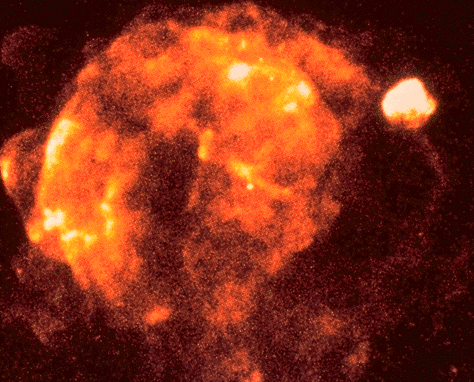
“What happens when a star explodes? A huge fireball of hot gas shoots out in all directions. When this gas slams into the existing interstellar medium, it heats up so much it glows in X-rays. The above picture by the ROSAT satellite has captured some of these X-rays and shown -- for the first time -- the Vela supernova explosion was roughly spherical. Non-uniformity of the interstellar medium causes Vela's appearance to be irregular. The size of this X-ray emitting spherical shell is immense - 230 light years across, covering over 100 times the sky-area of the full Moon. The supernova that created this nebula occurred about 1500 light years away and about 11,000 years ago. Coincidently, a completely different supernova shell can also be seen in X-rays in this picture! It is visible as the bright patch near the upper right. This Puppis supernova remnant nebula is actually about four times farther than the Vela nebula."
Copyright: Public domain
#360 Tomorrow's picture: June 13, 1996

“About 11,000 years ago a star in the constellation of Vela exploded. This bright supernova may have been visible to the first human farmers. Today the Vela supernova remnant marks the position of a relatively close and recent explosion in our Galaxy. A roughly spherical, expanding shock wave is visible in X-rays. In the above optical photograph, the upper left corner of the spherical blast wave is shown in detail. As gas flies away from the detonated star, it reacts with the interstellar medium, knocking away closely held electrons from even heavy elements. When the electrons recombine with these atoms, light in many different colors and energy bands is produced."
Copyright: Royal Observatory, EdinburghAnglo-Australian
Observatory
#361 Tomorrow's picture: June 14, 1996
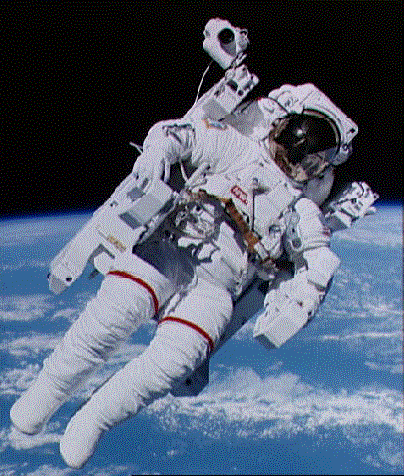
“NASA astronauts can float free in space without any connection to a spaceship. Here astronaut Bruce McCandless maneuvers outside the Space Shuttle Challenger by firing nitrogen gas thrusters on his manned maneuvering unit (MMU). This picture was taken in 1984 and records this first untethered spacewalk. The MMU was developed because astronauts found tethers restrictive."
Copyright: Public domain
#362 Tomorrow's picture: June 15, 1996
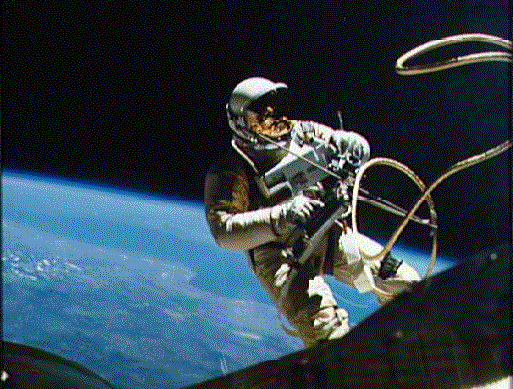
“Pictured above is the first american astronaut to walk in space: Edward White. White is seen floating outside the Gemini 4 capsule in 1965. The term "spacewalk" is deceiving since astronauts do not actually walk - they float - usually without their feet touching anything solid. White was connected to the spaceship only by a thick tether. He carried a Hand-Held Self-Maneuvering Unit which expelled gas allowing him to move around. A maneuvering device is necessary in the free-fall of space since there is nothing (besides the spacecraft) to push off of to guide movements."
Copyright: Public domain
Upvote! Resteem! Comment! As you like it! Thank you for attention!
Again my previous post is missing((( Stemit you make me sad
Downvoting a post can decrease pending rewards and make it less visible. Common reasons:
Submit